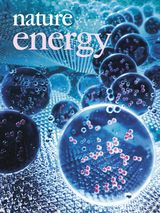Rice, Oak Ridge scientists show growing atom-thin sheets on cones allows control of defects

“Hands of Henry” (Nitant Gupta, c. 2017; WS2 on conical canvas)
Rice University researchers have learned to manipulate two-dimensional materials to design in defects that enhance the materials’ properties.
The Rice lab of theoretical physicist Boris Yakobson and colleagues at Oak Ridge National Laboratory are combining theory and experimentation to prove it’s possible to give 2-D materials specific defects, especially atomic-scale seams called grain boundaries. These boundaries may be used to enhance the materials’ electronic, magnetic, mechanical, catalytic and optical properties.
The key is introducing curvature to the landscape that constrains the way defects propagate. The researchers call this “tilt grain boundary topology,” and they achieve it by growing their materials onto a topographically curved substrate — in this case, a cone. The angle of the cone dictates if, what kind and where the boundaries appear.
The research is the subject of a paper in the American Chemical Society journal ACS Nano.
– See more at Rice News


